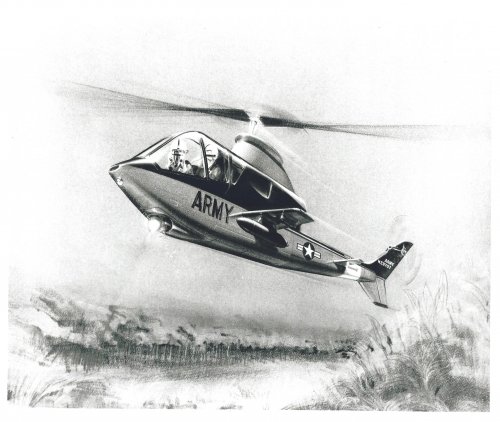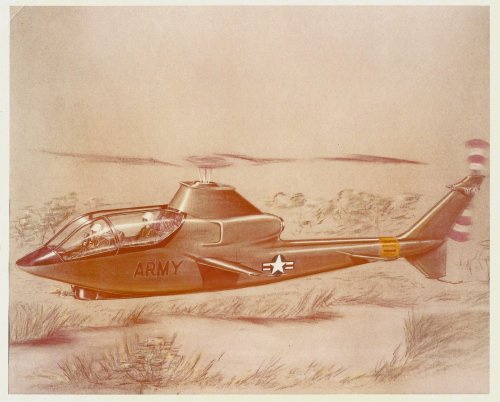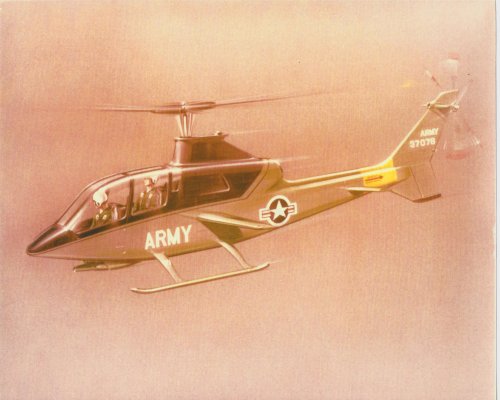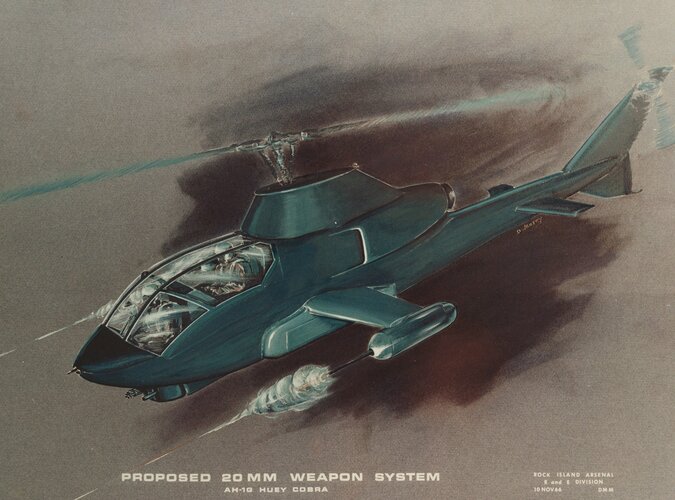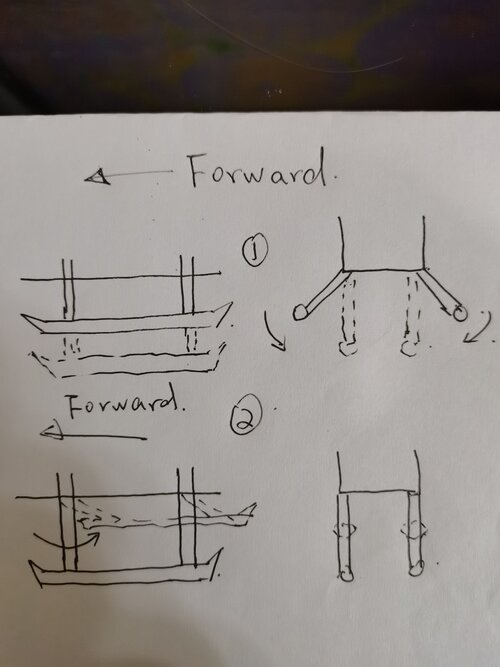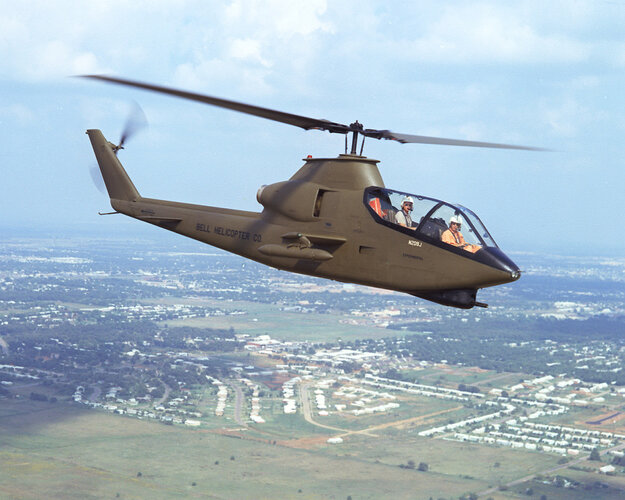You are using an out of date browser. It may not display this or other websites correctly.
You should upgrade or use an alternative browser.
You should upgrade or use an alternative browser.
‘Retractable Skidded’ AH-1 Cobra
- Thread starter Pioneer
- Start date
youROKer
ACCESS: Confidential
- Joined
- 15 May 2013
- Messages
- 107
- Reaction score
- 445
Attachments
- Joined
- 16 April 2008
- Messages
- 9,586
- Reaction score
- 14,417
I just found a picture that seems to actually show the retraction mechanism on the original AH-1 (Source: Smithsonian Magazine). This is really hard to make out in the relatively low-res pictures we have of the AH-1G in flight with the gear retracted.
It looks like the struts wouldrotate inward to a vertical position and fold aft so the skids would lift into those bays. Then the doors would hinge up to enclose the skids for s smooth appearance.
Edit: Found higher-res version of a picture earlier in the thread that helps understand this better. (Link, also from earlier in the thread). This shows that in fact, the struts would just fold inward and aft in a single movement -- the hinge pins on the skids are set up perpendicular to the plane of movement of the struts so that the skids would stay flat but follow the struts up and in to the bays. There are also little secondary doors that would fold down over the strut ends as they folded back. Very complex bit of engineering and it's totally clear why this went away so quickly.


It looks like the struts would
Edit: Found higher-res version of a picture earlier in the thread that helps understand this better. (Link, also from earlier in the thread). This shows that in fact, the struts would just fold inward and aft in a single movement -- the hinge pins on the skids are set up perpendicular to the plane of movement of the struts so that the skids would stay flat but follow the struts up and in to the bays. There are also little secondary doors that would fold down over the strut ends as they folded back. Very complex bit of engineering and it's totally clear why this went away so quickly.
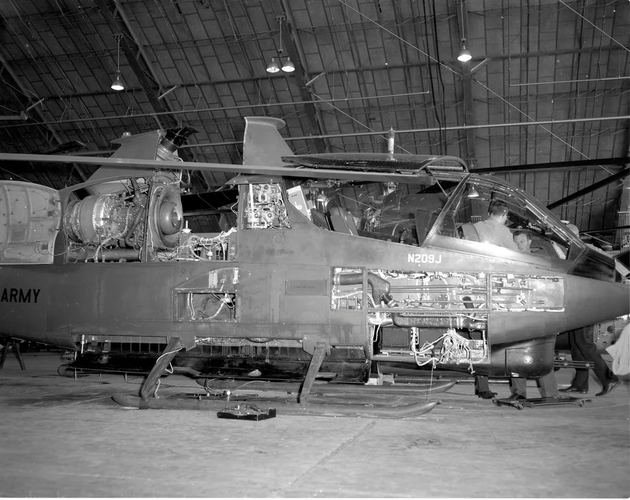
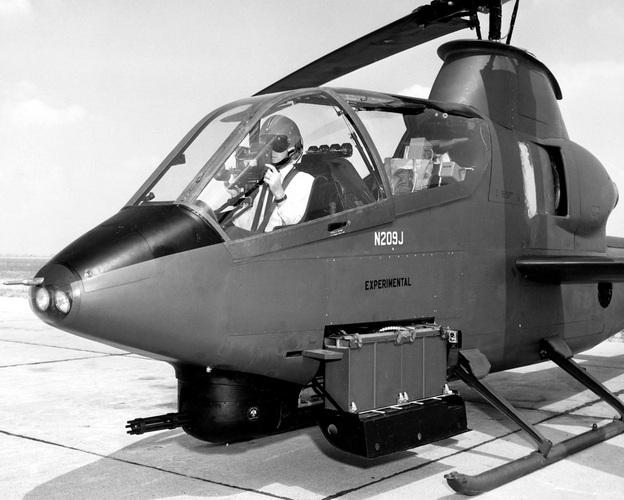
Last edited:
I just found a picture that seems to actually show the retraction mechanism on the original AH-1 (Source: Smithsonian Magazine). This is really hard to make out in the relatively low-res pictures we have of the AH-1G in flight with the gear retracted.
It looks like the struts wouldrotate inward to a vertical position andfold aft so the skids would lift into those bays. Then the doors would hinge up to enclose the skids for s smooth appearance.
Edit: Found higher-res version of a picture earlier in the thread that helps understand this better. (Link, also from earlier in the thread). This shows that in fact, the struts would just fold inward and aft in a single movement -- the hinge pins on the skids are set up perpendicular to the plane of movement of the struts so that the skids would stay flat but follow the struts up and in to the bays. There are also little secondary doors that would fold down over the strut ends as they folded back. Very complex bit of engineering and it's totally clear why this went away so quickly.
View attachment 686249
View attachment 686250
Attachments
- Joined
- 16 April 2008
- Messages
- 9,586
- Reaction score
- 14,417
I just found a picture that seems to actually show the retraction mechanism on the original AH-1 (Source: Smithsonian Magazine). This is really hard to make out in the relatively low-res pictures we have of the AH-1G in flight with the gear retracted.
It looks like the struts wouldrotate inward to a vertical position andfold aft so the skids would lift into those bays. Then the doors would hinge up to enclose the skids for s smooth appearance.
Edit: Found higher-res version of a picture earlier in the thread that helps understand this better. (Link, also from earlier in the thread). This shows that in fact, the struts would just fold inward and aft in a single movement -- the hinge pins on the skids are set up perpendicular to the plane of movement of the struts so that the skids would stay flat but follow the struts up and in to the bays. There are also little secondary doors that would fold down over the strut ends as they folded back. Very complex bit of engineering and it's totally clear why this went away so quickly.
View attachment 686249
View attachment 686250
Check my edit -- I think they move in a single plane rather than in and then aft in two motions.
Can you see my drawing?I just found a picture that seems to actually show the retraction mechanism on the original AH-1 (Source: Smithsonian Magazine). This is really hard to make out in the relatively low-res pictures we have of the AH-1G in flight with the gear retracted.
It looks like the struts wouldrotate inward to a vertical position andfold aft so the skids would lift into those bays. Then the doors would hinge up to enclose the skids for s smooth appearance.
Edit: Found higher-res version of a picture earlier in the thread that helps understand this better. (Link, also from earlier in the thread). This shows that in fact, the struts would just fold inward and aft in a single movement -- the hinge pins on the skids are set up perpendicular to the plane of movement of the struts so that the skids would stay flat but follow the struts up and in to the bays. There are also little secondary doors that would fold down over the strut ends as they folded back. Very complex bit of engineering and it's totally clear why this went away so quickly.
View attachment 686249
View attachment 686250
Is my understanding is right?
- Joined
- 16 April 2008
- Messages
- 9,586
- Reaction score
- 14,417
Can you see my drawing?I just found a picture that seems to actually show the retraction mechanism on the original AH-1 (Source: Smithsonian Magazine). This is really hard to make out in the relatively low-res pictures we have of the AH-1G in flight with the gear retracted.
It looks like the struts wouldrotate inward to a vertical position andfold aft so the skids would lift into those bays. Then the doors would hinge up to enclose the skids for s smooth appearance.
Edit: Found higher-res version of a picture earlier in the thread that helps understand this better. (Link, also from earlier in the thread). This shows that in fact, the struts would just fold inward and aft in a single movement -- the hinge pins on the skids are set up perpendicular to the plane of movement of the struts so that the skids would stay flat but follow the struts up and in to the bays. There are also little secondary doors that would fold down over the strut ends as they folded back. Very complex bit of engineering and it's totally clear why this went away so quickly.
View attachment 686249
View attachment 686250
Is my understanding is right?
I'm not sure. I can't tell whether the struts rotate to vertical first or just swing back at an angle.
Kat Tsun
eeeeeeeeeeeeeee
- Joined
- 16 June 2013
- Messages
- 1,366
- Reaction score
- 1,774
either way, i see what you mean about the complexity...ugh.
It folds back and under the fuselage. It's literally no more complex than a retracting wheel well on something like Comanche. Less, actually, since a lot of wheel wells tend to pull up wheels up, then back, but into much smaller spaces.
Complex for 1965 but hardly for helicopters in general. Retracting wheels are pretty common. Just off the top of my head: CH-53, NH90, Super Puma, and Merlin. It could be done pretty easily today with an electric motor if you don't like hydraulics, but overall the system looks less complex and more simply very bulky. Skids apparently need a lot more internal space that could be used for ammunition, armor, or fuel than wheels do.
The bigger issues are probably pilot ergonomics and the simple bulk of the system rather than maintenance or something. If guys can maintain Phantoms, H-43s, and H-3s in Vietnam they can maintain a retractable skid. OTOH given the intent of commonality in pilot training and operation of the AH-1, I suppose adding a gear switch seems to have been a step too far, and a lot of that space that it takes up later on includes things like the 20mm ammo bay, defensive jamming equipment (flares/chaff launchers), and RWRs.
AH-1Z probably wouldn't be possible if the Cobra as-built had these skids, for one thing. It would probably need even bigger sponsons. Not that anyone was thinking about that in 1965, but more just pointing out that volume is often more important than complexity. Plenty of aircraft, and even a few helicopters, will take a more complex solution if it's more volume efficient.
The retracting skids just seem to have the complexity of the retractable wheel wells with none of the volume efficiency to boot.
Last edited:
- Joined
- 18 October 2006
- Messages
- 4,203
- Reaction score
- 4,889
The decision to go with non-retracting skids was based on practicality (back when that was still a thing). The retraction did not significantly increase speed, nor reduce fuel consumption. It increased complexity and had a safety issue of only one skid extending. It added weight. So the Army elected to go with normal skids. The skids initially included aerodynamic cuffs. When it was noted that these were being quickly discarded in the warzone as unnecessary, the Army eliminated them as well.
Well, as long as you have moving parts…maybe tie the nacelles such that the skids come out as the fans rotate up?But the idea seems to have been interesting for others, too. Or
should I say : The cockpit section of the Cobra was so attractiv,
that Nord Aviation planned to bolt it to it's N.500 ducted fan VTOL
a/c, to get an attack version ? ;D
Similar threads
-
Bell UH-1 with retractable skids, large belly radar antenna
- Started by AeroFranz
- Replies: 10
-
S
-
-
-
AAH Competition (AH-64 rivals)
- Started by overscan (PaulMM)
- Replies: 8

